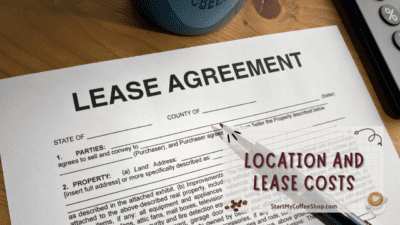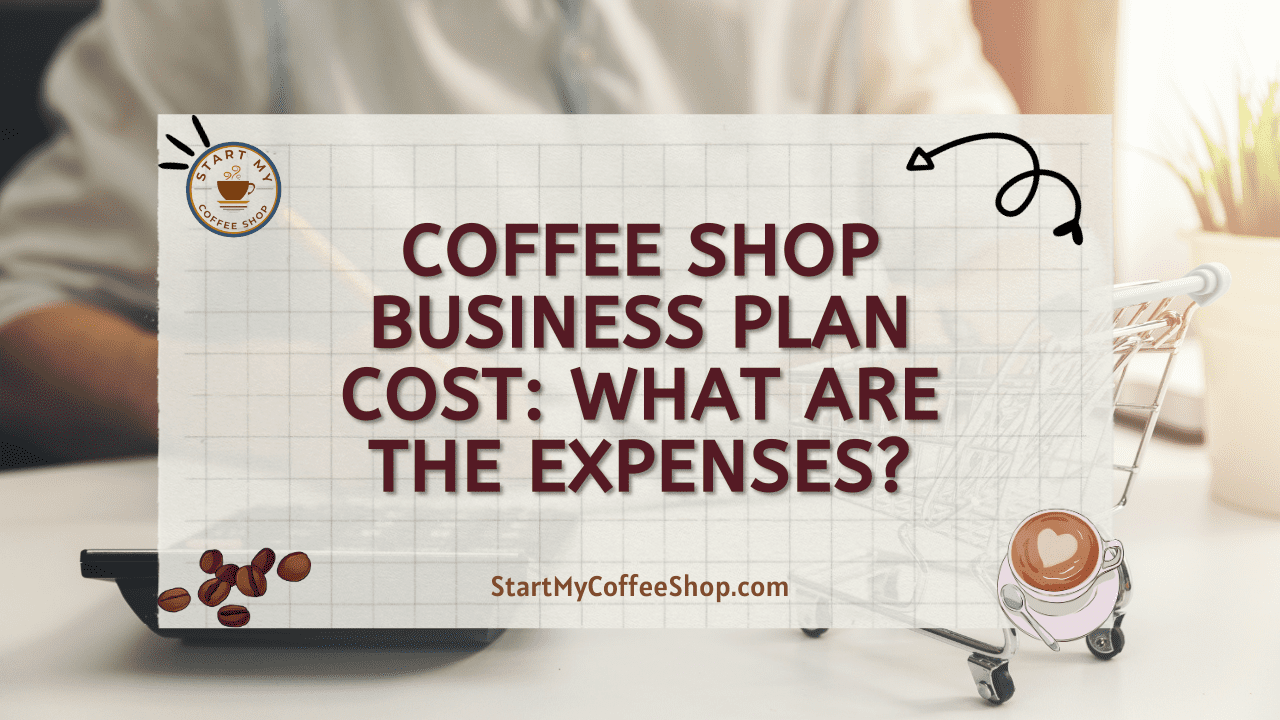Opening a coffee shop is an exciting venture for many aspiring entrepreneurs. However, before embarking on this caffeine-fueled journey, it is crucial to understand the costs involved.
Starting a coffee shop business requires careful consideration of various costs like location and lease, equipment, inventory, staffing, marketing, licenses, and operational expenses to create a realistic budget for your venture. A well-prepared financial plan sets the foundation for a great coffee shop.
In this article, I will delve into the various expenses associated with starting a coffee shop business and provide you with a comprehensive guide to help you plan your budget effectively.
1. Location and Lease Costs

When it comes to opening a coffee shop, selecting the perfect location is paramount. The cost of leasing space can fluctuate depending on several factors, including the city, neighborhood, and size of the premises. Expect prime locations in busy urban areas to demand higher rents due to the increased potential for customer flow. However, don’t discount the charm and affordability that less populated areas can offer.
While evaluating potential locations, consider the foot traffic in the area. A bustling area with high pedestrian activity can attract more customers to your coffee shop. Adequate parking availability is also crucial for customer convenience. Furthermore, think about the proximity to complementary businesses such as bakeries, bookstores, or offices. This can create opportunities for collaboration and cross-promotion, benefiting both parties.
Careful consideration of these factors will ensure that your chosen location aligns with your business goals. Balancing cost, accessibility, and market demand is key to finding the sweet spot for your coffee shop. Remember, a strategic location can significantly impact your coffee shop’s visibility, attracting a steady stream of loyal caffeine enthusiasts.
Read more about: Coffee Cafe Business Plan: A Blueprint for Caffeine Lovers
2. Equipment and Furnishings
EStart by considering the core equipment required, such as espresso machines, coffee grinders, brewers, refrigeration units, and POS systems. The cost of these items can vary depending on the quality and brand you opt for. It’s important to strike a balance between affordability and durability since these tools are vital for the seamless operation of your coffee shop.
In addition to the equipment, you must also factor in the costs associated with creating a welcoming ambiance for your customers. This includes seating, tables, lighting, signage, and decor. Comfortable seating arrangements, both indoor and outdoor, are crucial for customers to relax and enjoy their coffee. Choose furniture that aligns with your desired aesthetic and provides a comfortable experience.
Lighting plays a significant role in setting the mood and enhancing the atmosphere. Consider the type of lighting that best complements your coffee shop’s theme, whether it’s warm and cozy or bright and vibrant. Signage is essential for catching the attention of passersby and conveying your brand identity effectively. Invest in eye-catching and informative signage to attract customers.
Don’t overlook the power of decor in creating a unique and inviting space. Choose artwork, plants, or other decorative elements that reflect your coffee shop’s personality and create a pleasant environment for your customers. Keep in mind that the costs of furniture, lighting, signage, and decor can vary depending on your desired style and materials.
3. Inventory and Supplies
To cater to the diverse preferences of your customers, it’s crucial to have a well-stocked inventory of coffee beans, syrups, milk, tea, pastries, and other consumables. The first step is to research local suppliers and wholesalers who offer competitive prices while maintaining high-quality products. Establishing good relationships with reliable suppliers will ensure a steady and consistent supply chain for your coffee shop.
When it comes to coffee beans, explore different origins, blends, and roast profiles to provide a variety of options to your customers. Consider partnering with local coffee roasters who can provide freshly roasted beans for a distinct and flavorful experience. Syrups, such as vanilla, caramel, or hazelnut, can enhance the taste and customization of beverages, while various types of milk, including dairy alternatives, cater to different dietary preferences.
Expanding beyond coffee, include a selection of teas for non-coffee drinkers or those seeking alternative options. Additionally, stock up on pastries, baked goods, and snacks that complement your beverage menu. Partnering with local bakeries or hiring in-house pastry chefs can ensure the availability of fresh and delicious treats.
Managing inventory is crucial to avoid wastage, minimize costs, and meet customer demand. Implement an inventory management system to track stock levels, set reorder points, and monitor sales trends. This way, you can prevent overstocking or running out of essential items, optimizing your profitability.
Regularly review your inventory and make adjustments based on customer preferences and sales data. Stay attentive to seasonal variations and emerging trends in the coffee industry to update your offerings accordingly. This proactive approach will help keep your coffee shop fresh, relevant, and enticing to customers.
4. Staffing and Training

When considering staffing requirements, assess the number of employees needed to efficiently run your coffee shop. This typically includes baristas, cashiers, and kitchen staff, depending on the size and scope of your operations.
As you estimate staffing costs, account for wages, benefits, and payroll taxes. Research industry standards and local labor laws to ensure you meet legal requirements while remaining competitive in the job market. Striking a balance between fair compensation and your budget is essential to attract and retain talented individuals.
Investing in training programs is crucial for equipping your staff with the necessary skills and knowledge. Provide comprehensive training on coffee preparation techniques, including espresso extraction, latte art, and specialty drink recipes. Emphasize the importance of customer service, teaching your staff to engage with customers, handle inquiries, and resolve issues professionally. Moreover, prioritize training on hygiene standards and food safety protocols to maintain a clean and safe environment.
Allocating a budget for ongoing training and development programs is equally important. This ensures that your staff stays updated with the latest industry trends, brewing methods, and customer service techniques. Additionally, consider implementing a performance evaluation system to identify areas for improvement and provide constructive feedback to your employees.
Read more about: Coffee Business Start-up Costs: Average Costs to Consider
5. Marketing and Branding
Start by investing in professional logo design and branding materials that reflect the essence of your coffee shop. A visually appealing and memorable logo creates a lasting impression on potential customers. Develop a cohesive brand identity that extends across all touchpoints, including your website, signage, packaging, and employee uniforms.
Building an online presence is crucial in today’s digital landscape. Invest in website development to showcase your coffee shop’s offerings, location, and contact information. Ensure that your website is user-friendly, mobile-responsive, and optimized for search engines to improve your online visibility.
Embrace the power of social media marketing to connect with your audience and build a community around your brand. Establish profiles on popular platforms like Facebook, Instagram, and Twitter, and consistently share engaging content, such as coffee-related tips, behind-the-scenes glimpses, and customer testimonials. Consider partnering with local influencers who align with your brand values to reach a wider audience and generate buzz.
In addition to digital marketing, explore traditional advertising channels that resonate with your target market. This can include local print publications, radio spots, or even sponsoring community events. Participating in local events and collaborating with other businesses can also help boost brand awareness and foster community engagement.
To incentivize customer loyalty, consider implementing promotional deals and loyalty programs. Offer discounts or special offers for first-time customers or create a loyalty program that rewards frequent visitors. This encourages repeat business and word-of-mouth referrals, both of which are powerful marketing tools.
6. Licenses, Permits, and Insurance
Before opening your coffee shop, it’s crucial to ensure you have obtained all the necessary licenses and permits required by your local government. These may include health permits, business licenses, and food handling certifications. Research the specific requirements of your locality and allocate funds in your budget to cover the associated fees.
Health permits are essential to demonstrate that your coffee shop meets the necessary health and sanitation standards. This ensures that you provide a safe environment for both employees and customers. Business licenses are required to legally operate your coffee shop and vary depending on your location. Check with your local municipality or regulatory body to obtain the appropriate licenses.
Food handling certifications are often mandatory for businesses that serve food and beverages. These certifications validate that your staff is trained in proper food safety practices, including handling, storage, and preparation. It’s important to invest in training programs and ensure that your staff obtains the necessary certifications.
In addition to licenses and permits, it’s wise to invest in business insurance to protect your coffee shop against unexpected events. Business insurance can cover incidents such as accidents, theft, property damage, or equipment breakdowns. Consult with an insurance provider to determine the coverage that best suits your specific needs and budget.
7. Utilities and Operational Expenses

Operating a coffee shop involves a range of ongoing expenses that must be carefully considered and accounted for in your business plan. These recurring costs include rent, utilities, insurance premiums, and maintenance expenses. By including these in your financial projections, you can ensure the long-term sustainability of your operation.
Rent is typically one of the largest expenses for a coffee shop. The cost will depend on factors such as location, size, and demand. When selecting a space, carefully assess rental rates and negotiate terms that align with your budget. It’s crucial to strike a balance between a desirable location and manageable rental costs.
Utilities, including electricity, water, and internet, are essential for running your coffee shop smoothly. Explore energy-efficient equipment options, such as LED lighting and energy-efficient appliances, to minimize utility costs over time. Implementing smart practices like turning off unused equipment, optimizing temperature settings, and monitoring water consumption can also contribute to cost savings.
Insurance is another important expense to protect your coffee shop from potential risks. Premiums will vary based on factors such as coverage limits, location, and the size of your business. Consult with insurance providers specializing in the food and beverage industry to obtain comprehensive coverage that addresses your specific needs.
Maintenance costs should also be considered. Regular upkeep, preventive maintenance, and repairs are essential to keep your coffee shop running smoothly. Allocate a portion of your budget for routine inspections, equipment servicing, and unforeseen repairs. By investing in preventive maintenance, you can avoid costly breakdowns and extend the lifespan of your equipment.
Read more about: Utilities and Operational Expenses
Summary
Remember, a well-prepared financial plan sets the foundation for a great coffee shop, enabling you to provide a welcoming environment and exceptional coffee experience to your customers. So grab your favorite cup of joe and start brewing your dream coffee shop business today!
Frequently Asked Questions

1. What is the average cost of leasing a space for a coffee shop?
On average, it can range from $1,500 to $10,000 per month.
2. How much does coffee shop equipment cost?
Generally, you can expect to spend anywhere from $10,000 to $50,000 on essential equipment like espresso machines, grinders, brewers, and refrigeration units.
3. What should I budget for coffee shop inventory and supplies?
Budgeting for coffee shop inventory and supplies depends on factors like the menu, volume of customers, and product variety. It is advisable to allocate around 25-35% of your monthly revenue toward inventory and supplies.
To learn more on how to start your own coffee shop, check out my startup documents here.
Disclaimer: The information provided by StartMyCoffeeShop.com (“The Site”) is for general informational purposes only. All information on the Site is provided in good faith. However, we make no representation or warranty of any kind, express or implied, regarding the accuracy, adequacy, validity, reliability, availability, or completeness of any information on the Site. Under no circumstance shall we have any liability to you for any loss or damage of any kind incurred as a result of the use of the Site or Reliance on any information provided on the Site. Your use of the Site and reliance on any information on the Site is solely at your own risk. This blog post is for educational purposes only and does not constitute legal advice. Please consult a legal expert to address your specific needs. Terms and Conditions. (https://startmycoffeeshop.com/terms-and-conditions/)

Hi! I’m Shawn Chun
My adventure in coffee began when I first launched my first coffee shop back in the early 2000s. I had to figure out so many things on my own and to make it worse within 2 years of opening two large corporate coffee chains moved in just blocks away from me!
As I saw smaller and even some larger coffee shops in the neighborhood slowly lose customers to these giant coffee chains and slowly close up shop, I knew that I had to start getting creative…or go out of business.
I (like you may be) knew the coffee industry well. I could make the best latte art around and the foam on my caps was the fluffiest you have ever seen. I even had the best state-of-the-art 2 group digital Nuova Simonelli machine money could buy. But I knew that these things alone would not be enough to lure customers away from the name brand established coffee shops.
Eventually, through lots of trial and error as well as perseverance and creativity I did find a way to not only survive but also thrive in the coffee/espresso industry even while those corporate coffee chains stayed put. During those years I learned to adapt and always faced new challenges. It was not always easy, however, in the end, I was the sole survivor independent coffee shop within a 10-mile radius of my location. Just two corporate coffee chains and I were left after that year. All told the corporate coffee chains took down over 15 small independent coffee shops and kiosks and I was the last one standing and thriving.
Along the years I meet others with the same passion for coffee and I quickly learned that it is not only “how good a barista is” that makes a coffee shop successful, but the business side of coffee as well.
Hence why I started this website you are on now. To provide the tools and resources for up and coming coffee shop owners to gain that vital insight and knowledge on how to start a coffee shop successfully.
Stick around, browse through my helpful blog and resources and enjoy your stay! With lots of LATTE LOVE!
Shawn







